Understanding Learnership Stipends in South Africa: What You Can Expect to Earn

Learnership Stipends in South Africa: What You Need to Know in 2025
In South Africa, learnerships serve as a powerful bridge between education and employment. For thousands of unemployed youth, they are a lifeline—offering both structured training and practical work experience. But one common question remains: How much do you actually get paid on a learnership?
The answer isn’t as straightforward as a single number. Instead, stipend amounts vary depending on several factors, including the qualification level, the sector involved, and whether you’re entering the job market for the first time. This guide dives into everything you need to know about learnership stipends in South Africa, helping you navigate expectations and plan ahead.
🌱 What Is a Learnership Stipend?
A learnership stipend is a monthly allowance paid to a learner for the duration of their training programme. Unlike a full salary, this amount is designed to support your basic needs—such as transport, food, and other essentials—while you work towards a formal qualification.
The stipend is not considered a salary or wage. It’s essentially a grant or financial aid tied directly to your participation in the programme.
🧮 How Much Can You Expect to Earn on a Learnership?
The stipend amount can differ across industries, companies, and qualification levels. However, most learnership stipends in 2025 typically fall between R2,500 and R8,000 per month.
Here’s a breakdown to help you understand what influences the figure:
📊 Stipend Range by the Numbers
| Factor | Typical Range or Impact |
|---|---|
| General Range (Most Learnerships) | R2,500 – R8,000/month |
| Entry-Level Learnerships | R2,500 – R4,000/month |
| Technical or Advanced Fields | R5,000 – R8,000/month |
| MICT SETA (IT-related) | Often fixed at R2,500/month |
| Automotive Learnership (Example) | Up to R6,500/month |
| Credits-Based Minimum (SAFLII) | R204.47 to R933.74/week (depending on credits) |
🧭 What Influences the Amount You Receive?
Several factors can affect how much you’ll earn during your learnership. Here are the most significant ones:
1. NQF Level of the Learnership
The National Qualifications Framework (NQF) is South Africa’s system for categorizing educational achievements. It ranges from Level 1 (Grade 9 equivalent) to Level 10 (Doctorate).
- Lower NQF Levels (1-4): These typically pay less as they are entry-level qualifications.
- Mid-Level NQF (5-6): Higher stipends may apply here, especially for fields like business administration or finance.
- Higher NQF Levels (7+): Learnerships at this level are rare but often include higher compensation due to their complexity.
Additionally, employers who support learners at lower NQF levels can qualify for greater tax incentives, which might allow them to offer more competitive stipends.
2. New Entrant vs. Existing Employee
If you’re unemployed and joining a learnership for the first time, you are referred to as a “new entrant.” These learners generally receive standard stipend rates, often at the lower end of the scale.
In contrast, existing employees who participate in learnerships may already earn a salary and receive additional incentives or bonuses through the learnership programme.
3. Sector and SETA Involvement
Different Sector Education and Training Authorities (SETAs) manage learnerships across various industries. The stipend depends heavily on the sector’s financial capabilities and available funding.
- Services SETA – Learnerships here often range from R3,000 to R5,500.
- MICT SETA (Media & IT) – Often fixed at around R2,500.
- FASSET SETA (Finance & Accounting) – Can offer higher stipends, sometimes exceeding R6,000.
- Wholesale and Retail SETA – Varies widely based on employer size and region.
4. Number of Credits Earned (Sectoral Determination No. 5)
According to SAFLII’s Sectoral Determination No. 5, stipend rates are also affected by how many credits a learner earns through the programme. More credits typically indicate a longer or more advanced programme.
| Credits | Minimum Weekly Stipend |
|---|---|
| 0 – 120 | R204.47 |
| 121 – 240 | R408.94 |
| 241 – 360 | R615.25 |
| 361 – 480 | R933.74 |
These figures translate to monthly stipends of roughly R820 to R3,700, offering a legal minimum that companies must comply with.
5. Location and Employer Budget
In urban centres like Johannesburg, Cape Town, or Durban, stipends may be higher due to increased living costs. Small businesses in rural areas might pay closer to the minimum allowance.
Additionally, employers with larger training budgets or those backed by corporate social responsibility initiatives often pay more to attract high-potential learners.
💡 Real-World Learnership Stipend Examples
To bring these numbers to life, here are some real-life examples from public programmes and company announcements:
- MICT SETA IT Learnership: R2,500 per month, fixed stipend.
- Automotive AA Learnership: Up to R6,500 per month, often including travel assistance.
- Retail SETA Learnership: Between R3,000 and R5,000 depending on NQF level.
- Banking Learnership (FASSET SETA): May pay up to R8,000/month for skilled or advanced learners.
🏦 Tax Benefits for Employers (and What It Means for You)
Under South African tax law, employers receive tax rebates and deductions for every learner they place in a learnership. This is especially true when learners complete their qualifications.
- The incentive encourages employers to offer more learnerships, indirectly benefiting learners.
- Some companies reinvest these savings to increase stipend amounts or offer additional learning resources.
⚖️ Your Rights as a Learner
If you’re part of a learnership, it’s important to know that:
- You must receive a stipend, no matter your experience level or background.
- The stipend must be clearly stated in your learnership agreement.
- You are not expected to pay for training or workplace experience.
- You’re entitled to the stipend even if the company is receiving government funding.
🎯 Why Stipends Matter in the Bigger Picture
While the money you earn on a learnership may not make you rich, it can help:
- Cover transportation and lunch costs.
- Reduce financial pressure during your studies and training.
- Encourage higher completion rates, as learners are less likely to drop out due to cost.
The stipend also reflects a commitment to youth empowerment and skill-building in a country where unemployment is still high among young people.
📌 Final Thoughts: What to Expect in 2025 and Beyond
As government policy continues to support youth development, learnership stipends are likely to become more standardised and accessible. SETAs and training providers may also introduce flexible or performance-based stipends in the near future.
In short, if you’re planning to join a learnership in 2025, you can reasonably expect a stipend in the range of R2,500 to R8,000 per month, depending on your field, location, and qualification level. It’s not just about earning a monthly allowance—it’s about investing in your future.
✅ Quick Summary: Key Learnership Stipend Facts
- 💸 Average Range: R2,500 – R8,000/month
- 🎓 Based on NQF Level: Higher NQF = Higher potential stipend
- 🧾 Minimum Legal Allowance: R204 – R933/week based on credits (SAFLII)
- 🏢 Employer Incentives: Tax benefits help support stipend payments
- 📍 Sector & Location Impact: SETA, industry, and geography matter



